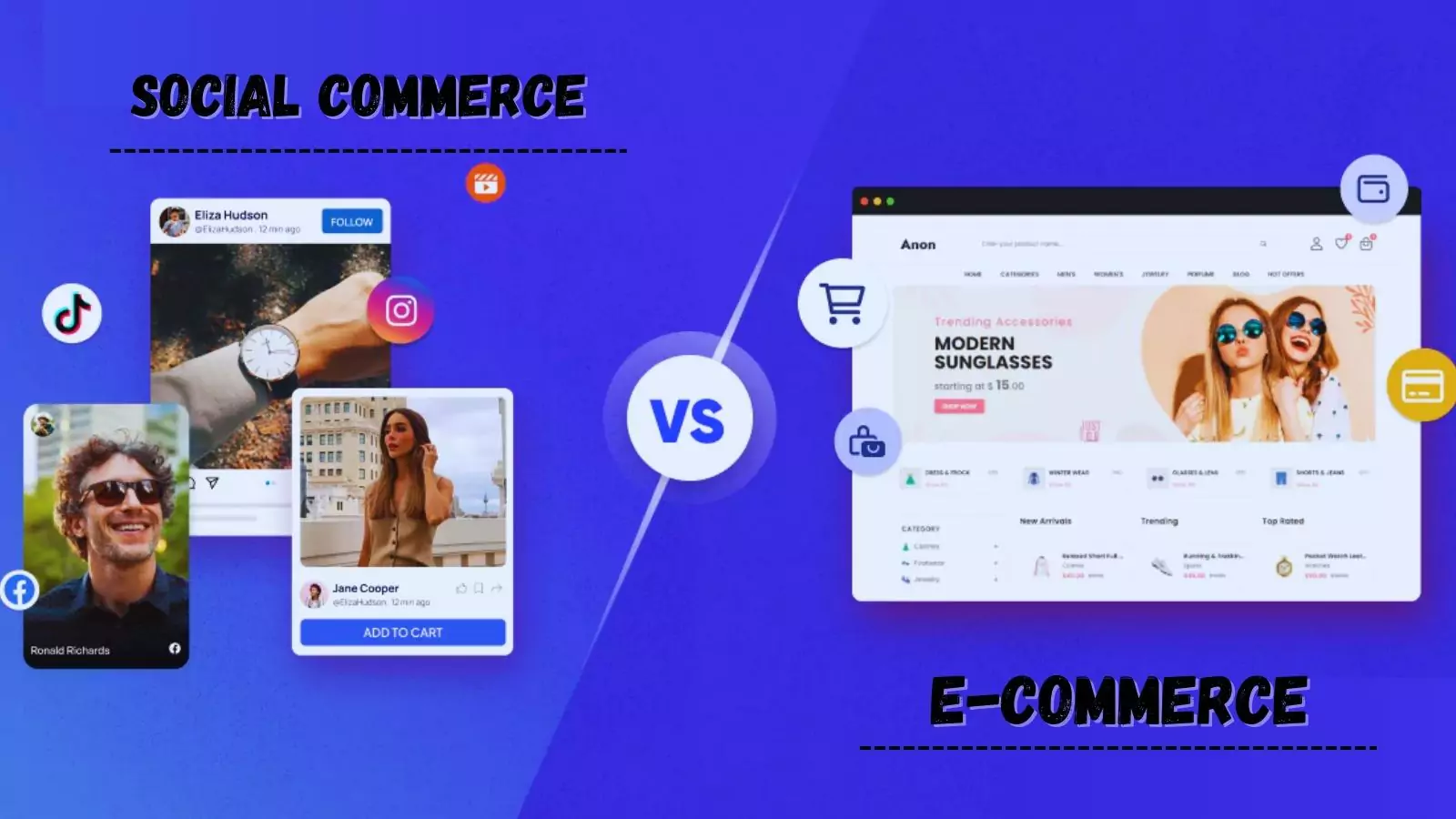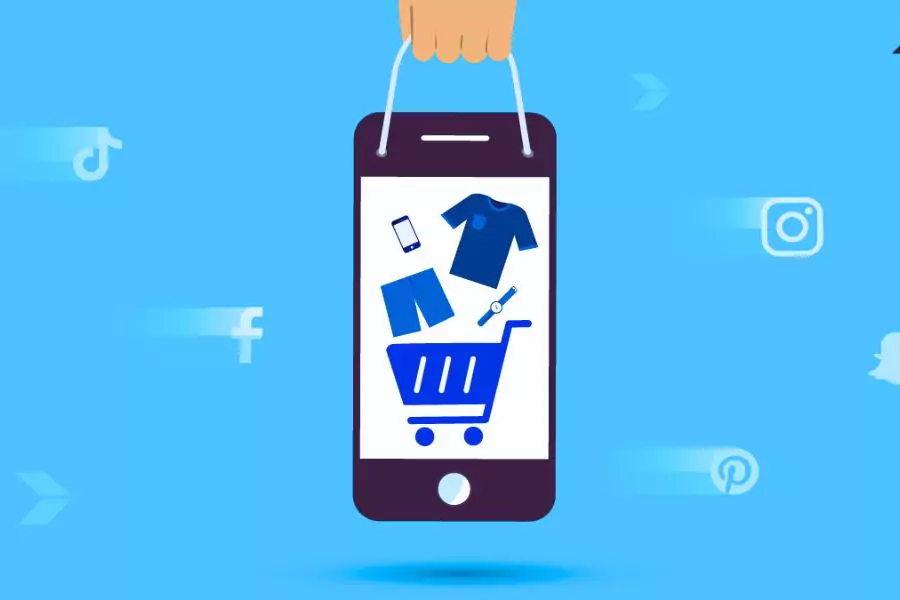What is Social Commerce? Tips and Trends {2024}
The evolution of e-commerce has taken a compelling turn with the rise of social commerce. This dynamic fusion of social media and online shopping is reshaping how businesses interact with customers and influence purchasing choices.
From Instagram boutiques to Facebook Marketplace, social commerce is revolutionizing the way we buy and sell goods online.
But what exactly is social media commerce, and why is it gaining momentum? In this comprehensive guide, we’ll delve into the fundamentals of social selling, explore effective- strategies for leveraging its power, and uncover the latest trends shaping its future.
Let’s start!
In a hurry? Listen to the blog instead!
What Is Social Commerce?
Social commerce leverages social networking platforms to advertise and sell products and services. It integrates the entire shopping journey within sites such as Facebook, Instagram, and X platform (formerly Twitter), where businesses promote their offerings, and consumers can browse, shop, and make purchases.
The effectiveness of a social selling campaign is measured- by consumer engagement metrics like shares, likes, and retweets of the company’s marketing content.
Social Commerce Vs. ECommerce
- E-commerce utilizes websites or apps where the customer can opt to purchase any brand of products. In contrast, social media commerce enables purchases within social media platforms, capitalizing on spontaneous buying moments.
- Social marketing commerce relies on platforms like Facebook, Twitter, and Instagram to engage potential customers and drive conversions, whereas traditional e-commerce focuses on methods like advertising, and SEO which improves e-commerce ads to boost sales.
- Social media selling tends to be more cost-effective than e-commerce as it eliminates the need for extensive website development and maintenance. However, relying solely on social commerce may not suffice for generating significant revenue.
- Social platforms utilize advanced algorithms and data mining to gather implicit and explicit user data, offering insights not easily accessible through standalone websites.
- E-commerce involves actively driving traffic to a separate website for purchases. In contrast, social marketing commerce takes place directly on social media platforms.
How Social Commerce Works?
Social commerce refers to the direct sale of products and services through social media platforms. It uses tools like forums and communities where buyers and sellers discuss their shopping experiences and preferences. This type of online marketing combines social media and shopping, especially popular in fashion and shopping blogs, which use it to encourage followers to buy products they showcase.
Professionals in social selling create and share posts and interactive content to boost online sales. They use various tactics like inviting users to vote on product styles, offering personalized shopping options, using eye-catching graphics and videos to showcase products, and encouraging user engagement through comments and photos.
Popular fashion blogs often link their Instagram posts directly to shopping carts, allowing followers to easily- buy items they like. The success of social media commerce campaigns is often measured by how much engagement they get from consumers- more likes, shares, and comments typically mean a more successful campaign.
Key Social Commerce Statistics Every Marketer Should Know:
- Platform Popularity: Facebook is expected to have the most buyers through social selling in 2024, with around 64.6 million users.
- Instagram Influence: Approximately 46.8 million buyers are projected- to make purchases through Instagram in 2023.
- Rising Penetration: The social marketing penetration rate increased by 23.6% in 2023 and is expected to rise another 5% by 2028.
- Investment Intentions: By 2024, half of the marketers intend to boost their spending on social selling.
- Influence of Generations: 32% of Gen Z and 21% of Millennials make purchases- based on influencer recommendations.
- Investment in Influencer Marketing: A significant 26% of brands and marketing agencies plan to allocate over 40% of their marketing budget to influencer marketing activities, with 22.4% planning investments between 10-20%.
- Market Size Growth: The global influencer market was valued at $15.2 billion in 2022 and is expected to exceed $22 billion by 2025, reflecting its increasing importance in social media commerce strategies.
7 Effective Tips And Tools For Social Commerce Success
You’ve set up your digital shop, but now it’s time to maximize its potential. Here are essential tips and tools to help you thrive:
Automate Customer Service with AI Chatbots-
Efficiently handle customer inquiries and boost sales with AI-powered chatbots. These tools integrate seamlessly with your online store and social media channels, providing real-time assistance and automating up to 80% of customer support interactions.
Engage Authentically with Your Audience-
Social commerce is inherently social. Engage actively with your followers by answering questions, sharing valuable content, and maintaining an authentic presence. You can also use chatbots to guide customers through their shopping journey directly on social media platforms.
Strategic Social Listening-
Implement strategic social listening to monitor comments, shares, and customer feedback on your social commerce platforms. Utilize tools like PowerAdSpy to stay updated on industry trends and gather valuable insights directly from your audience. PowerAdSpy can enhance your social listening strategy by providing detailed analytics on competitor ads, revealing what resonates with your target market, and helping you refine your campaigns for maximum impact.
Encourage Customer Reviews-
Reviews significantly influence purchasing decisions. Prompt satisfied customers to leave reviews through automated follow-up emails or incentivized campaigns. Showcase positive feedback creatively on your social feeds to build trust and credibility.
Targeted Marketing-
Utilize robust social media data to precisely target your ideal customers. Leverage analytics to optimize your reach and ensure your products are seen by the right audience segments.
Optimize Product Pricing-
Price products strategically for social commerce. Products priced under $70 tend to perform well due to their impulse-buy appeal and lower perceived risk. Align your pricing strategy with consumer behavior observed in social media commerce environments.
Integrate eCommerce Platforms with Social Media Enhance your social media commerce strategy by integrating eCommerce platforms such as Shopify with social networks. This integration enhances the online shopping experience for customers by ensuring products are effectively showcased where your audience is most active.
These tips and tools, like PowerAdSpy, empower you to navigate and succeed in the dynamic landscape of social selling, complementing your broader digital marketing efforts effectively. PowerAdSpy specifically aids- in optimizing your social media campaigns and product placements by providing insights into competitor ads and strategies, thereby enhancing your overall approach to social media commerce.
PowerAdSpy: Ad Intelligence Tool
It is a powerful tool in digital marketing, renowned for its comprehensive capabilities in ad intelligence. These are designed to empower marketers with deep insights into their competitors’ advertising strategies.
PowerAdSpy offers a variety of features that make it a must-have in any marketer’s toolkit.
- Extensive Ad Database: Access a vast repository of ads from diverse platforms, enabling a comprehensive view of the competitive landscape.
- Advanced Search and Filters: Utilize powerful search and filtering options to pinpoint specific ads based on keywords, demographics, ad type, and more, ensuring highly targeted research.
- Competitor Analysis: Gain insights into competitors’ ad strategies, including creatives, targeting methods, and performance metrics, to inform your campaigns.
- Performance Metrics: Analyze engagement metrics such as likes, shares, comments, and impressions to identify high-performing ads and understand audience preferences.
- Creative Inspiration: Explore a variety of ad formats and creatives to inspire your own campaigns, from images and videos to ad copy and calls to action.
- Real-time Alerts: Set up notifications to stay updated on new ads from specific competitors or within particular categories, ensuring you never miss a trend.
- Comprehensive Reporting: Generate detailed reports to track ad performance over time and make data-driven decisions to refine your advertising strategies
PowerAdSpy is a powerful ally for businesses navigating the complexities of social commerce. By leveraging its robust features for ad intelligence, competitor analysis, performance tracking, and trend identification, businesses- can optimize their social selling efforts, enhance customer engagement, and achieve sustainable growth in the competitive digital landscape.
Social Commerce Trends To Watch For 2024
 Rise of AR Experiences: Augmented Reality (AR) and Virtual Reality (VR) are gaining popularity, with projections indicating 104.3 million Americans using AR and 73.7 million using VR by 2024. Social media platforms like Snapchat, Instagram, and TikTok are pivotal in introducing users to AR through filters and lenses, enabling retailers to showcase products virtually and enhance the online shopping experience.
Rise of AR Experiences: Augmented Reality (AR) and Virtual Reality (VR) are gaining popularity, with projections indicating 104.3 million Americans using AR and 73.7 million using VR by 2024. Social media platforms like Snapchat, Instagram, and TikTok are pivotal in introducing users to AR through filters and lenses, enabling retailers to showcase products virtually and enhance the online shopping experience.
Expansion of Video Content:
Video continues to dominate social media, influencing consumer purchasing decisions significantly. Platforms like Instagram Reels and Facebook are embracing shoppable video formats, encouraging brands to create engaging content that showcases products in action and includes direct shopping links to drive conversions.
Micro-Influencers for Authentic Reach:
Collaborating with micro-influencers remains a potent strategy in 2024, with 81% of consumers trusting influencer recommendations over traditional marketing. Influencers with smaller but engaged audiences offer cost-effective opportunities for brands to connect authentically with diverse demographics.
Rise of Livestream Shopping:
Live commerce, combining influencer marketing with real-time shopping experiences, is expected to grow significantly. Platforms are enhancing capabilities for live interactions and seamless checkout processes, leading to higher conversion rates and reduced return rates compared to traditional e-commerce marketing.
User-Generated Content (UGC) as Social Proof:
Authentic content generated by users continues to play a crucial role in building trust and influencing purchasing decisions. Brands are leveraging shoppable UGC to showcase real-world product experiences, tapping into nearly 80% of consumers who are influenced- by such content.
Integration of AI-powered Chatbots:
AI-driven chatbots are becoming integral to social commerce, offering personalized customer interactions and facilitating transactions directly within social media platforms. Features like Instagram’s “Get Paid in Chat” streamline the purchasing process, meeting consumer expectations for seamless shopping experiences.
Enhanced Social Shopping Experiences:
Brands are focusing on creating effortless social shopping experiences by integrating features like Instagram Checkout and one-tap purchases. This approach aims to reduce barriers to purchase and enhance customer loyalty by providing convenient, familiar shopping environments directly on social media platforms.
These social & e-commerce advertising trends underscore the evolving landscape of social media commerce in 2024, highlighting opportunities for brands to innovate and engage consumers in new and impactful ways.
Best Platforms For Social Commerce In 2024:
As social commerce gains momentum, several platforms have emerged as key players in enabling direct sales through their ecosystems. Here’s a look at some of the well-known platforms and their social marketing capabilities:
Facebook:
Facebook Shops provide a straightforward entry point into social media commerce. Setting up a shop is free and integrates seamlessly with your Facebook business profile. You can sync your product inventory quickly if using a partner platform or manually upload via a spreadsheet. The Shop tab within the mobile app enhances organic brand discovery by showcasing products based on user preferences. Customers can complete purchases directly within the app or visit your website.
Instagram:
Instagram Shopping is closely tied- to Facebook Shops. By linking your Instagram business account to your Facebook profile, you can upload and manage your product catalog. Utilize Instagram Product Tags to make your posts and videos shoppable, allowing users to tap on tags for product details. The “View shop” button enables browsing of your entire catalog, ensuring a seamless shopping experience either within the app or on your website.
Pinterest:
Pinterest Shopping facilitates direct sales by allowing businesses to upload product catalogs to their Pinterest business page. Product Pins enable tagging within Pins, allowing users to click through for more information. While purchases still redirect to product-specific landing pages, Pinterest simplifies the buying journey by providing comprehensive product details upfront.
These best ecommerce platforms continue to innovate and expand their social media commerce features, providing businesses with powerful tools to reach and convert customers directly through social media interactions.
Also Read,
Top 10 Ecommerce Advertising Strategies You Can’t Afford To Ignore
05 Trends To Unleash The Power Of eCommerce Advertising
Best Ecommerce Ads Strategies To Transform Your Business
Examples Of Social Commerce
Explore how leading brands are leveraging social media platforms to innovate their commerce strategies:
- Domino’s Pizza automates orders through Facebook Messenger
- Mac Cosmetics introduces shoppable AR Lenses on Snapchat
- Gap curates shopping lists using Instagram Guides
- Nike utilizes Product Pins on Pinterest
- Best Buy Canada integrates a Shop tab on Facebook
These examples highlight how brands are creatively using social media platforms to enhance their ecommerce advertising strategies, driving engagement and sales directly within popular social environments.
The Bottom Line
Social media platforms have evolved beyond mere personal connections and content sharing. They now serve as vibrant hubs for social marketing, where users can seamlessly connect with brands and marketers to browse, shop, and complete purchases directly within their favorite social networks.
This integration of e-commerce into social media enhances the shopping experience, offering convenience with just a click. As social commerce- continues to grow, and also leveraging ad spy tools like PowerAdSpy can empower businesses to optimize their strategies and effectively navigate this dynamic landscape.
FAQs
1. What is social commerce?
Social media commerce refers to the buying and selling of goods and services directly through social media platforms. It integrates shopping features into social networking sites, allowing users to browse, select, and purchase products without leaving the platform.
2. Which social media platforms support social commerce?
Major platforms- like Facebook, Instagram, Pinterest, and YouTube have integrated social media commerce features. These platforms allow businesses to set up shops, tag products, and enable in-app purchases, enhancing the shopping experience for users.
3. What are the benefits of social commerce for businesses?
Social media commerce offers businesses a direct channel to reach and engage with their target audience. It increases brand visibility, drives sales through personalized recommendations, and provides valuable insights into consumer behavior through social interactions and analytics.
4. Is social commerce the same as social media marketing?
No, they are distinct concepts. Social media marketing focuses on promoting- your brand and products through social media platforms. In contrast, social media commerce specifically involves conducting sales transactions directly within social media environments. While social selling can leverage the benefits of social media marketing, it serves different
purposes within the digital business landscape.
5. What are some examples of social commerce?
Social media commerce encompasses various forms of online shopping directly facilitated through social media platforms. Examples include integrated shopping features on platforms like Facebook and Instagram (e.g., Facebook and Instagram Shops), peer-to-peer marketplaces (like Facebook Marketplace, Craigslist, and eBay), curated shopping lists (such as Pinterest’s Shopping Lists), live shopping events (such as those on Facebook Live), and interactive shopping experiences enabled by shoppable AR filters (like Snapchat’s shoppable Lenses).










